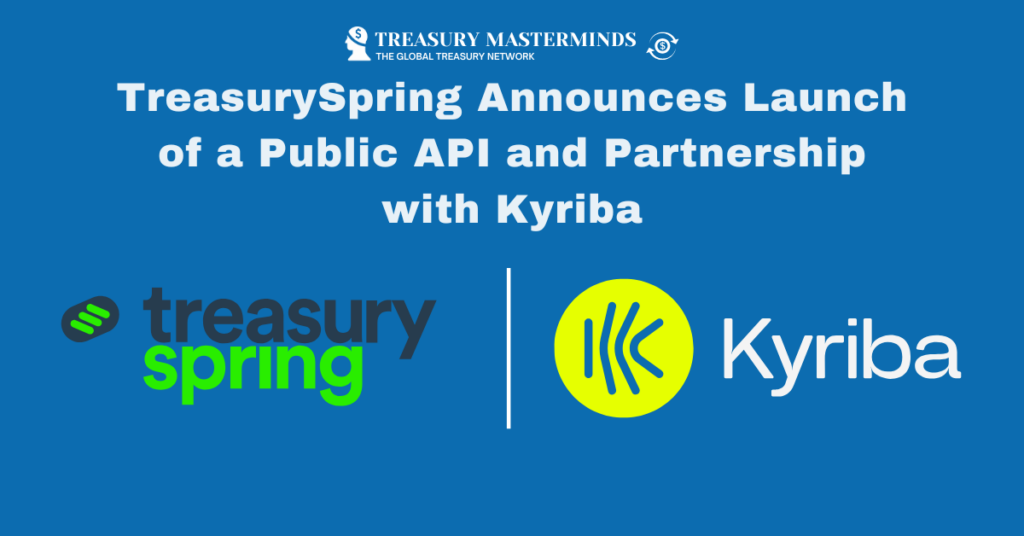
TreasurySpring Announces Launch of a Public API and Partnership with Kyriba
[London, New York, 12 March 2025] – TreasurySpring, the global cash investment platform, has announced its API collaboration with Kyriba, a global leader in liquidity performance. Kyriba customers will now be able to access TreasurySpring’s suite of wholesale cash products ranging from collateralized repo from leading international banks to government securities and corporates. Kyriba’s AI-driven App Studio platform aims to eliminate “liquidity gridlock,” simplify API adoption, and streamline integrations for any software that supports APIs, including Enterprise Resource Planning (ERP). By endeavouring to empower finance teams to automate and control connectivity workflows without requiring technical expertise, Kyriba’s secure and scalable SaaS solution aims to help CFOs, treasurers, and IT leaders to connect, protect, forecast, and optimize their liquidity. The collaboration marks the launch of TreasurySpring’s first public API release, which provides select customers with the ability to view and access TreasurySpring’s fixed-term products across 90+ issuers and eight currencies, as well as the ability to view holdings and exposures across counterparties. This follows TreasurySpring’s recent expansion into the US to meet the needs of its growing US client base. As part of this growth, Tom Ryan was appointed Global Head of Partnerships, based in New York and US CEO & Global Head of Capital Markets, Henry Adams, has relocated to strengthen TreasurySpring’s on-the-ground presence in the US. Tom Ryan, Global Head of Partnerships, TreasurySpring said: “Platforms such as Kyriba play a critical role in helping our customers manage, forecast, and invest their cash, and we look forward to working with additional partners to expand access to TreasurySpring. The launch of our public API is a significant landmark moment for us as we continue to strengthen and grow the business in the UK, US and beyond.” Félix Grévy, Vice President Product, Open API and Connectivity, Kyriba added: “In an environment of continued market uncertainty, CFOs and Treasurers are turning to AI-driven SaaS solutions to automate workflows, enhance decision-making, and streamline cash forecasting. At Kyriba, our API-first strategy enables seamless connectivity between critical financial applications, empowering finance teams with real-time insights and greater control over their liquidity. By integrating TreasurySpring into Kyriba’s Marketplace, we are expanding access to innovative cash investment solutions that optimize liquidity performance and efficiency for our customers worldwide. Also Read
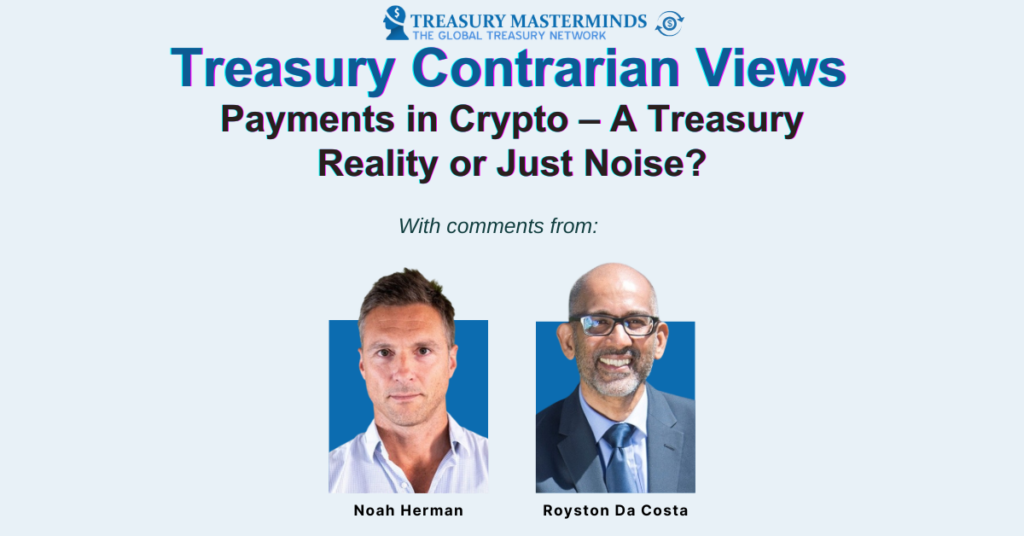
Treasury Contrarian View: Payments in Crypto—A Treasury Reality or Just Noise?
Cryptocurrency has been a hot topic in financial markets for years, but is it truly a viable payment method for corporate treasury, or is it just hype? While some companies have begun accepting and using crypto for payments, others remain skeptical about its practicality, volatility, and regulatory implications. So, should treasurers take crypto payments seriously, or is it still too risky and impractical? The Case for Crypto in Treasury The Case Against Crypto in Treasury The Balanced Approach: Testing the Waters Rather than fully committing to crypto, treasury teams can take a measured approach: Let’s Discuss We’ll be sharing insights from treasury leaders and industry experts—join the conversation and share your perspective! COMMENTS Noah Herman, Fortris Chief Revenue Officer, comments: The question of crypto payments in corporate treasury isn’t about hype – it’s about practical, strategic integration. While volatility and regulatory challenges are legitimate concerns, they’re manageable through thoughtful strategy, risk management, and proper infrastructure. Solutions like stablecoins and instant conversion into traditional currencies such as USD mitigate the perceived risks and offer clear paths to adoption without unnecessary exposure to volatility. However, instant conversion means companies miss out on the chance to fully operationalize crypto within their business, whether that be through balance sheet diversification or better cross-border payments. A “hands-on” approach to crypto payments means companies can explore these opportunities to the full but comes with two main challenges: security and interoperability. Take compatibility with existing TMS and ERP solutions as a case in point. Treasury teams are understandably reluctant to move away from their trusted tech stacks, but blockchain-based currencies aren’t compatible with those. We believe the answer lies in ensuring any new solution works with the existing back-office setup, without the need for manual processes that erode the time and cost savings of crypto payments. As for real-world adoption, we’ve observed this tends to move in step with regulatory developments and sea-change moments such as the approval of the first Bitcoin exchange-traded funds in the United States. More regulatory clarity and shifts in accounting guidance – such as the FASB’s move to fair-value measurement for assets including Bitcoin – provide an increasingly robust framework for finance teams to work with. These developments make adoption far less daunting. Ultimately, crypto payments are becoming a treasury reality – not overnight, but steadily, as organizations build comfort through strategic testing and practical use cases. Treasurers who explore proactively today will be well-positioned to capture tomorrow’s opportunities. Royston Da Costa, Treasury Masterminds board member, comments: From my experience, the key to integrating digital assets into treasury lies in cautious, measured steps. For example, while organizations like Save the Children have begun accepting crypto donations, they convert these assets into fiat immediately to minimize financial risks. This aligns with the idea of testing the waters, as mentioned in the article. I’m more optimistic about the potential of digital currencies—including CBDCs—which I believe will eventually become a more regulated, stable, and scalable alternative. These will likely offer the benefits of speed, cost, and transparency, without the extreme volatility that cryptocurrencies currently present. For treasurers, the focus should be on staying informed and being ready for future developments. Until regulation and infrastructure catch up, we should remain cautious but prepared for what’s to come. Also Read Join our Treasury Community Treasury Mastermind is a community of professionals working in treasury management or those interested in learning more about various topics related to treasury management, including cash management, foreign exchange management, and payments. To register and connect with Treasury professionals, click [HERE] or fill out the form below to get more information. Notice: JavaScript is required for this content.

Debunking the top 5 misconceptions about currency hedging
This article is written by our content partner, Ebury Understanding foreign exchange markets and hedging is essential for businesses looking to manage FX risk and succeed globally. Unfortunately, several myths linger around that can hold you back and lead to poor decision-making. Here, let’s debunk five common myths related to FX and hedging to help you manage your FX risk effectively. Myth 1: “Hedging is a headache—complicated, costly, and time-consuming!” Reality: Actually, it can be surprisingly simple and cost-effective with the right strategy, policy, and products (options, forwards *). And compared to the headaches and risks of not hedging (think: unpredictable pricing, cash flow chaos, potential loss of competitiveness, inaccurate budgeting), which is way worse, investing in a hedging strategy is always a wise decision. At Ebury, we help you design the strategy that’s just right for your business without all the fuss. Myth 2: “Hedging? Sounds like speculating or timing the market.” Reality: Not at all! Say, for instance, you have fixed prices. If your costs increase while prices stay the same, you have reduced your profit margins. Hedging helps you fix your costs for a period and brings certainty and future visibility to your finances. Imagine you know exactly what your costs will be for the next year. No more guessing games or tracking market movements daily! Myth 3: “Currency fluctuations? They primarily impact importers and exporters.” Reality: Even if you are not an importer or an exporter, your business is exposed to FX risks if you hold investments in other currencies or borrow funds in foreign currencies. For example, you are a European business with a 1-year investment of USD 100,000. If the EUR/USD rate depreciates, it will impact your investment value after a year. Any unwanted exchange rate volatility can unpredictably impact margins and cash flows, especially if your business makes frequent FX transactions. Myth 4: “FX policy is not for my business. Only large businesses and their treasury teams should worry about it.” Reality: Any business trading internationally, regardless of size, should have a plan and not leave its profit margins to chance. Think of an FX policy as your profit protection plan against unwanted currency volatility. And the good part: we’ve enabled companies of all sizes and across most industries to protect their budgets from unwanted currency volatility and can also help your business. Myth 5: “Hedging strategy is the same for all. I don’t need an FX partner to design it for my business.” Reality: Every business has unique circumstances, risk appetite, needs, goals, budget, and tenor expectations. Therefore, there is no universally applicable approach to hedging. That’s where Ebury comes in. We get to know your business and build a hedging strategy unique to your business. Like a tailored suit, not some off-the-rack thing. Final thoughts Any business can make informed decisions, effectively manage currency risks, and prepare themselves for success in international markets with the right hedging partner, knowledge, and tools. Also Read Join our Treasury Community Treasury Masterminds is a community of professionals working in treasury management or those interested in learning more about various topics related to treasury management, including cash management, foreign exchange management, and payments. To register and connect with Treasury professionals, click [HERE] or fill out the form below. Notice: JavaScript is required for this content.
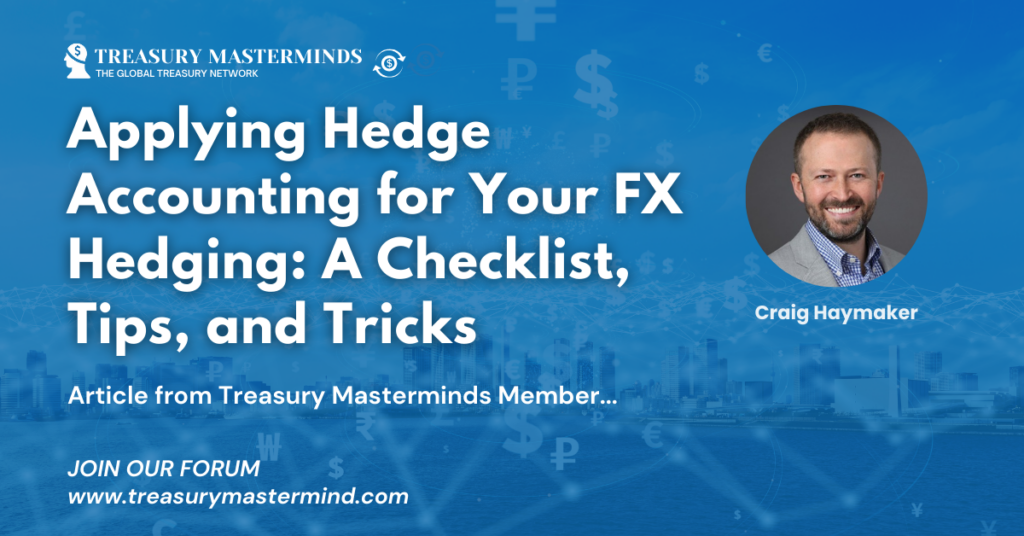
Applying Hedge Accounting for Your FX Hedging: A Checklist, Tips, and Tricks
Written by Craig Haymaker Hedge accounting is powerful. It allows corporate treasurers to manage the risk inherent in foreign exchange (FX) exposures while reducing earnings volatility. By aligning the accounting for hedging instruments with the underlying risk exposure, hedge accounting provides a more accurate reflection of economic reality. However, hedge accounting can be complex and time-consuming without sufficient experience and knowledge of the guidance. While IFRS 9 introduced flexibility in certain areas, IAS 39 remains relevant for some organizations due to its stricter rules for hedge accounting qualification. Here’s a comprehensive checklist, along with actionable tips and tricks, to streamline the process under either framework. 1. Understand the Basics of Hedge Accounting Standards The two most commonly applied accounting standards for hedge accounting are IAS 39 and IFRS 9: Tip: Check which standard applies to your organization. If transitioning from IAS 39 to IFRS 9 is an option, assess how the flexibility of IFRS 9 might benefit your processes and reporting. Both standards recognize three primary types of hedges for FX: A clearly defined hedge relationship will involve a hedging instrument, or portfolio of hedging instruments, and a hedged item. Often, the hedging instrument is a derivative designed to reduce risk based on its underlying asset, rate, or index. The hedged item represents the critical terms of the risk exposure being hedged. Hedged item(s) could be assets, liabilities, forecasted cash flows, or equity-related balances driving the variability in expected future cash flows, changes in fair value, or reported investments in foreign operations. Both the hedging instrument(s) and hedged item(s) must be carefully and comprehensively identified within an entity’s documentation. 2. Build a Strong Hedge Accounting Framework A robust framework ensures compliance regardless of the standard you follow. Key elements include: Checklist: Tip: Use treasury management systems (TMS) to automate documentation and effectiveness testing to reduce manual errors and meet requirements. 3. Choose the Right Hedging Instruments The choice of hedging instruments must align with both your risk profile and the accounting standard requirements. Common instruments include forwards, options, and currency swaps. Tip: Under IAS 39, certain instruments (e.g., peculiar options) may not qualify due to stricter eligibility rules. Stick to simple and liquid instruments like forward contracts and vanilla options to simplify compliance. Trick: IFRS 9 allows you to exclude items such as changes in time value or forward points. For example, when hedging anticipated expenses denominated in a foreign currency across a given time period, the excluded forward element can be amortized to the statement of profit / loss over the life of the hedge, easing earnings impact. 4. Accurately Forecast FX Exposures For cash flow hedges, forecasted transactions must be “highly probable” to occur in order to qualify as an eligible hedged item under both IAS 39 and IFRS 9. Checklist: Tip: Involve key stakeholders (e.g., FP&A, procurement, and sales teams) to improve forecast accuracy and compliance. 5. Conduct Regular Hedge Effectiveness Testing Under IAS 39, hedge effectiveness must fall within the strict range of 80-125%, making it more challenging to qualify. IFRS 9, however, allows more qualitative or principle-based assessments, provided the hedge relationship is aligned with the risk management objective. Checklist: Trick: If your hedge fails effectiveness testing under IAS 39, consider redesignating the hedge using a different hedging strategy or hedging an alternative risk exposure to reset compliance and recapture earnings stability. 6. Understand Hedge Ineffectiveness and Adjustments Hedge ineffectiveness can arise from mismatches in the timing, currency, or amount of the hedged item and the hedging instrument. Valuation adjustments arising from the risk of non-performance, or counterparty credit risk, can also create a mismatch. This is because counterparty credit risk is considered only for the hedging instrument and not the hedged item. Tip: Avoid mismatches by ensuring critical terms (e.g., amount, currency, and maturity) between the hedging instrument and the hedged item are aligned. Trick: For cash flow hedges under IFRS 9, use hypothetical derivatives to mirror the critical terms of the hedged item to simplify ineffectiveness measurement. Applying a hedge ratio to the hypothetical derivative can help promote a highly effective hedge relationship. 7. Stay Compliant with Your Applicable Standard Compliance with accounting standards is non-negotiable. IAS 39 is more stringent in several areas, including hedged item eligibility criteria, testing, and measurement. IFRS 9 introduces simplifications and greater flexibility that reduce operational burdens while maintaining transparency. Checklist: Tip: Keep comprehensive documentation of hedge accounting processes and test results, especially if your organization still applies IAS 39. 8. Leverage Technology for Efficiency Whether under IAS 39 or IFRS 9, manual processes can be error prone. Treasury management systems (TMS) or specialized hedge accounting software can streamline your operations. Tip: Look for solutions that support dual compliance if you operate in jurisdictions requiring IAS 39 and IFRS 9 simultaneously. Trick: Automate repetitive tasks like hedge documentation, effectiveness testing, and compliance reporting to reduce administrative overhead. Final Thoughts Applying hedge accounting for FX hedging requires a well-structured framework, accurate data, and meticulous execution. While IAS 39 remains relevant for some organizations, IFRS 9 offers increased flexibility, making it worthwhile to explore transitioning if allowed. By following this checklist and leveraging the tips and tricks provided here, you can simplify the complexities of hedge accounting, enhance risk management, and achieve better alignment with your hedging strategy. Are you ready to optimize your FX hedging and embrace hedge accounting under the relevant standard? Share your thoughts, experiences, or questions in the comments below! Also Read Join our Treasury Community Treasury Mastermind is a community of professionals working in treasury management or those interested in learning more about various topics related to treasury management, including cash management, foreign exchange management, and payments. To register and connect with Treasury professionals, click [HERE] or fill out the form below to get more information. Notice: JavaScript is required for this content.
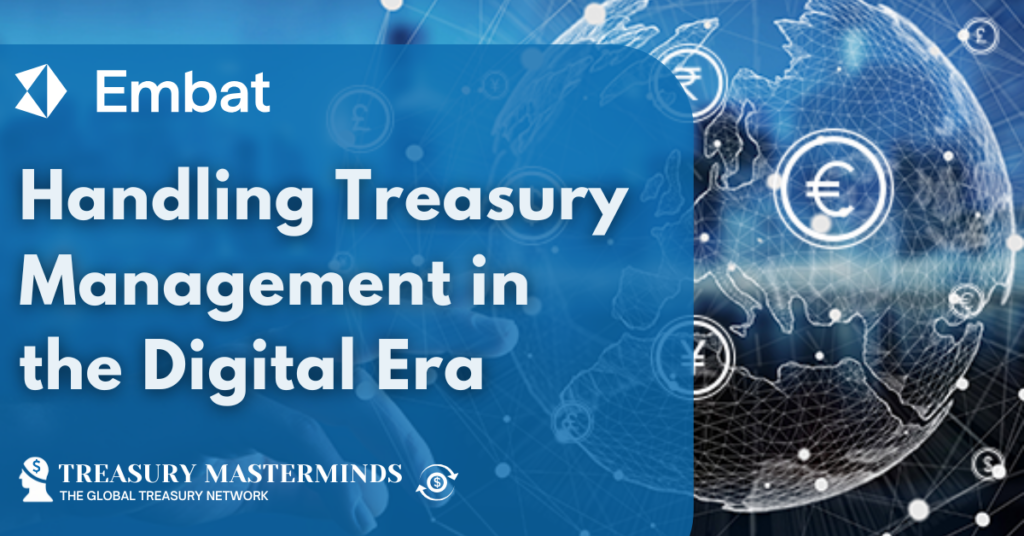
Handling Treasury Management in the Digital Era
This article is written by Embat In today’s digital age, treasury management has become more complex but, at the same time, more efficient. Companies no longer rely solely on cash and cheques for their routine financial transactions. There are now multiple payment options and digital tools available within this critical business process. For this reason, it’s crucial to manage cash properly to avoid future financial issues, and companies must pay special attention to their treasury. In this article, we’ll explore key strategies and insights for optimising corporate treasury operations in the digital era, helping to improve efficiency and ensure financial stability. Treasury and technology: a winning combination Without a doubt, cash is the most important asset of any company. It enables the financing of daily operations, investment in fixed assets, payment to suppliers, settlement of taxes, and maintenance of liquidity reserves for emergencies and unexpected events. Therefore, treasury management is increasingly vital, and new methods are continually being sought to optimise this important process. Treasury and digital transformation make for a winning combination, as it essentially allows the modernisation of business systems. However, for this process to be truly effective, it is important that treasury management is integrated with the rest of the company’s systems, such as asset management systems, accounting systems, or payment systems, among many others. The goal is not only to centralise all operations in one place but also to enable a banking connectivity channel between the company and the bank, allowing daily communication to flow much more smoothly. In this way, a real-time treasury is achieved, available from any location and device, and adaptable to the needs of each business. Benefits of digital applications in treasury management There are several advantages and benefits to using digital applications in treasury management. The following are some of the key highlights: Task automation Modern technologies, such as artificial intelligence and robotic process automation (RPA), can help automate many of the manual and repetitive tasks carried out in treasury. In fact, almost all activities in this department are susceptible to being automated through technology and digitalisation. These tasks include bank reconciliation, cash flow reporting, or fund transfers to clients and suppliers, among many others. Such actions reduce human errors, increase process efficiency, and enhance overall performance. Cost reduction Digital transformation, when applied to a company, drives significant cost reductions by minimising human errors. In the context of financial management, such errors can result in substantial losses, making the accuracy and efficiency brought by digital tools crucial for safeguarding the company’s finances. Moreover, digital treasury also enables the consolidation of bank accounts, reducing fees and improving the negotiation of rates with banks. Finally, by having real-time visibility of accounts in banks, companies can optimise balances and cash flows, which decreases financing costs and, consequently, improves the company’s profitability. Risk reduction Digital treasury systems provide the right tools for financial risk management. This helps companies make informed decisions about financial risk management and reduces the risk of financial loss in real-time and without any friction. Furthermore, digital treasury ensures regulatory compliance, such as verifying the applicant’s identity, monitoring transactions, and generating reports. Digital treasury systems can help companies comply with financial regulations and avoid penalties and fines for non-compliance, as they are quickly updated based on current legal requirements. Better cash flow management Digital systems allow centralised cash flow management in one place, in real-time, with the possibility of being updated and reviewed by anyone, on any device, and from anywhere. Additionally, they provide useful tools for cash flow forecasting, helping companies plan their short- and long-term cash needs. Treasury teams can use these systems to create cash flow forecasting models and simulate different financial scenarios. This allows them to identify potential risks and financing opportunities, helping them make more informed decisions about cash management. Top tools for treasury management in the digital era There are various tools for managing treasury in the digital era. Below are some of the most common and popular ones: Treasury management software This type of software can include features such as risk management, cash flow forecasting, and bank reconciliation, specifically designed for corporate treasury management. It may operate as a standalone solution or be integrated into a broader ERP (Enterprise Resource Planning) system. Embat is integrated with the main ERPs on the market, such as SAP, Oracle NetSuite, Microsoft Business Central, and Sage. Treasury management software can be customised to suit a company’s specific needs and can be used to manage multiple bank accounts and currencies. Electronic payment systems Electronic payment systems enable the receipt and sending of electronic payments, which can be particularly useful for companies conducting online transactions. These systems use secure networks and communication protocols to facilitate money transfers and online payments. Such payment systems offer businesses numerous advantages, including greater convenience and security for users, the elimination of cash and cheques, and improved efficiency in processing payments. Additionally, they provide enhanced security and can be integrated into accounting and finance systems to facilitate the management and tracking of a company’s financial transactions. Online banking tools and bank connectivity Most banks offer online banking tools that allow for the management of accounts and transactions, which can be especially useful for managing multiple bank accounts. Furthermore, some companies offer peer-to-peer (P2P) bank connectivity protocols to create a direct communication channel between the company and the bank. These tools enable access to bank account information on demand through bank statements, as well as automating payment management (with transfers, confirming, etc.) or the receipt of collections (with direct debits, for example). Cash flow forecasting tools Cash flow forecasting tools allow for the prediction of future cash flows and the identification of potential liquidity problems. Some of their main features and characteristics include: Why not integrate all these features into a single platform? In reality, it would be fantastic to have all these features available in one place, wouldn’t it? Well, such comprehensive solutions do exist, offering an automated, efficient, and secure treasury for finance teams. Among these solutions are the treasury management solutions offered by Embat. With our comprehensive cloud-based treasury solution you can…
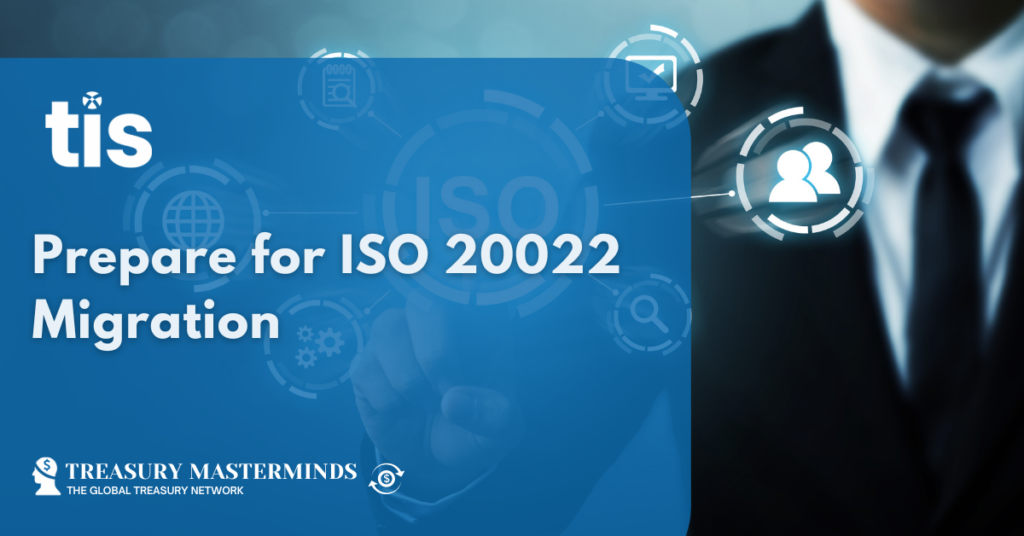
Prepare for ISO 20022 Migration
This article is written by TIS Payments 2025 is a critical year for one of the most significant transformations within the financial landscape: the migration to ISO 20022, the new universal messaging standard for payments. It is estimated that by the end of this year, 80% of high-value payments will be ISO 20022-based, with Swift phasing out legacy MT messages. This shift represents more than a simple messaging update; it’s an opportunity for treasurers to enhance automation, compliance, and efficiency in their cash and payments operations. Why ISO 20022 Matters for Treasurers ISO 20022 brings a richer data structure, enabling faster, more transparent, and more structured, compliant payments processing. This reduces errors, enhances reconciliation, and strengthens compliance with regulatory requirements. For corporate treasurers, this is an opportunity for: However, as the migration to ISO 20022 progresses and MT legacy formats continue to coexist alongside the newer XML standards, several challenges arise. On the corporate side, many systems are not yet equipped to process the new formats or to provide the richer information required. This misalignment could lead to business disruptions due to issues in payment execution, reconciliation challenges, and process gaps that require manual intervention. As a result, businesses face an increased operational risk. Additionally, they are not able to fully leverage the benefits that ISO 20022 offers. Therefore, corporate finance professionals must take proactive steps to ensure that their businesses are prepared for the changes ahead. One important question you might need to ask yourself is: Are your back-end systems ready to fully digest the new ISO 20022 messages and to migrate all relevant formats globally to bank- and country-specific ISO XML? Actionable Steps for Treasurers To ensure a seamless transition, treasurers and other financial professionals should proactively assess their payment processes and banking relationships: How TIS Supports ISO 20022 Migration TIS stands on the forefront of ISO 20022 readiness for global payments execution. This includes the capability to read legacy payment formats and transform them into ISO XML, ensuring that clients can maintain their smooth and automated end-to-end payment operations, even if their back-office systems are not yet able to adhere to ISO 20022 standards. TIS has the capability to enrich the address data sets with the master data stored in TIS and transform the unstructured into structured data sets as per the ISO 20022 standard. On the bank-to-business side, TIS is able to split accumulated bank files, which makes the data easier to distribute and consume for the different back office systems, and avoids unnecessary data duplication and large file sizes. TIS can also gather and merge individual bank files to complete bank statement files, if a bank has not yet fully transitioned to ISO 20022 standards, but the corporate’s back-office systems are ready. TIS clients receive complete account statement files without the need to build or develop their own solutions. Additionally, TIS unifies the data sent from the different banks. Clients don’t need to worry about the different versions (camt.053v.02, v.03, etc) and the different data structures. Translation from any camt.053 version is possible – with the additional ability, to transform bank-country-specific versions to a unified MT940 version, as a solution for businesses whose back-office systems are not ISO 20022 ready yet. Conclusion: ISO 20022 A Strategic Opportunity Now is the time to engage with banking partners, review internal systems, and embrace the benefits of this transformative change. The capabilities described above, coupled with the fact that TIS already integrated hundreds of back-office systems, supports thousands of different payment types, maintains over 140,000 unique payment profiles, and invests in ongoing development and maintenance of these and new formats to ensure future-proofing, make TIS the ideal vendor for corporations with global payment operations and a complex back-office systems landscape when transitioning to ISO 20022. Also Read Join our Treasury Community Treasury Mastermind is a community of professionals working in treasury management or those interested in learning more about various topics related to treasury management, including cash management, foreign exchange management, and payments. To register and connect with Treasury professionals, click [HERE] or fill out the form below to get more information. Notice: JavaScript is required for this content.

Treasury Contrarian View: Should Treasury Be a Profit Center?
Traditionally, treasury has been seen as a cost center—a function focused on managing liquidity, risk, and financial operations rather than generating revenue. But as treasury teams gain access to more sophisticated tools, data, and financial instruments, a provocative question arises: Should treasury operate like a profit center rather than a cost center? The Case for Treasury as a Profit Center The Case Against Treasury as a Profit Center The Middle Ground: Treasury as a Value-Adding Function Instead of classifying treasury strictly as a cost or profit center, companies can take a hybrid approach: Let’s Discuss We’ll be sharing insights from treasury leaders and industry experts—join the conversation and share your perspective! COMMENTS: Gurjit Pannu, Co-Founder/Co-CEO at Palm, comments: In the end, viewing the treasury as a potential profit center does not mean abandoning its foundational responsibilities. Instead, it means leveraging the treasury’s unique position—access to company-wide cash flows, market insights, and strategic relationships—to both safeguard the firm’s financial health and, where appropriate, capture additional value. Nick Franck, Treasury Masterminds board member, comments: I agree completely, but suggest the terminology gets in the way. A) A basic treasury does cash managementB) A more advanced treasury does liquidity management and passive risk management, including hedging This, when done well, handles the known-unknowns. What about the unknown-unknowns? Non-treasury created situations that are existential risks. 80% of companies go out of business because they become insolvent. That makes it a treasury matter. What does a company need to handle unknown-unknowns?👉 Experts in the financing and the financial markets👉 People, systems and processes that enable real-time control as well as support of the experts in whatever they do👉 Policies that allow the people above to do their work flexibly, in real-time – ie, without CFO approval for every significant action👉 Management who understand the above and set strategies and policies to enable the above Unknown-unknown crises don’t happen all the time. How can senior management know whether the treasury function is fit for purpose and can react well in real time. 💡 Make them manage real-time changing markets➡ If they don’t make profits, they’re not fit for purpose ‘Profit-centre’ treasuries are also ‘Better controlled’ treasuries Patrick Kunz, Treasury Masterminds Founder/board member, comments: Profit center is too strong of a statement imho. That would imply risk taking and profit as a goal. Treasury goal is preservation of cash and minimisation of risk but only treating that as a cost center is too weak as well. Cost minimisation is easy and the basic thing to do as a treasurer. A great treasurer vs a basic treasurer treats his treasury as a company. Leveraging opportunities for new investments (while keeping risk the same), finding ways to optimise payment flows, new financing counterparties, just to name a few things to do.Be an “entrepreneur” inside the company. You are the guardian of the cash and the protector but also like to keep the treasury full for as long as possible. In practise this means the treasurer has to collaborate internal to drive improvements, to increase risk awareness or to get better data quality. Be an ambassador for the treasury department inside the company and create awareness about cash (is king). That is where the “profit” starts. Also Read Join our Treasury Community Treasury Mastermind is a community of professionals working in treasury management or those interested in learning more about various topics related to treasury management, including cash management, foreign exchange management, and payments. To register and connect with Treasury professionals, click [HERE] or fill out the form below to get more information. Notice: JavaScript is required for this content.

Can Data Processes Cope with a Surge in M&A?
This article is a contribution from our content partner, Kyriba There are good reasons to be confident about the prospects for mergers and acquisitions in 2025. The US regulatory climate is expected to loosen under a second Trump administration, corporates have pent-up cash reserves to spend, and interest rates are expected to remain at current levels or drop in the near term. A surge in M&A activity would be good news for private funds, but will require savvy data management so GPs can access and deploy their internal data for a faster, more rigorous investment process, says Thomas Gavaghan, a VP of global presales for the global leader in liquidity performance solutions Kyriba. Q: What do you expect the private funds landscape to look like in 2025? Let’s start with what our proprietary research says. Kyriba found that corporate liquidity for companies in the US has reached $3.5 trillion out of combined revenues of $16 trillion which is a 20 percent liquidity to revenue ratio. The highest level since 2021, yet M&A deals are currently 2,000 fewer total transactions in volume, suggesting a ‘wait and see’ stance among corporations. And we see liquidity as a leading indicator of M&A activity. There’s really been this hoarding of cash for years now, where corporates have been shifting their capital structure to stockpile cash given the high levels of uncertainty. Now there’s a stabilization period, where even though it’s a high interest rate environment, it’s a stabilized one. The Fed recently said while they might consider cutting rates, they might not in the near term, just to prolong the current stability. So the next question is what will corporates do with all that liquidity? And the sense is that it will be chan neled into M&A activity, at pre-covid levels. That comeback is also likely to be helped by the sense that the regulatory environment will be more enticing, since we already saw what the first Trump administration did, and we can expect some continuation of that stance. What complicates the regulatory climate is expected anti-money laundering reforms and ESG demands, which will leave market participants a little more cautious as well, with an eye to making sure that they are fully com pliant with current expectations. And at a macro level, the discourse around tariffs can’t be ignored. The potential for increased tariffs in the US could lead to companies seeking supply chain realignment to focus on domestic production in order to mitigate the potential impact, as in, looking to merge or acquire with companies that have the capabilities they need domestically, in a certain amount of regionalization, or as I would put it, a move away from centralization to a controlled decentralization. So, GPs will have to navigate these various pockets, even as the overall M&A market picks up steam. Q: What should private funds managers be doing now, or in the first few months of 2025 to prepare for all that M&A activity? For private funds, or really any sector right now, a lot of the focus is around data: access to it and information around it so that it can be easily acted upon. And the promise of AI is fueling this even more, as that technology requires robust, accurate data. But strictly from a private funds manager’s perspective, one of the key priorities is gaining and ensuring complete visibility of liquidity so that they know where it is, what they have, what they don’t have, what they can tap into on their credit facilities within capital calls and things like that. This requires centralizing that information to make sure that it’s not living inside of different spreadsheets owned by different managers. Placing it in a single spot where it can be accessed is key. “For private funds, or really any sector right now, a lot of the focus is around data: access to it and information around it so that it can be easily acted upon. And the promise of AI is fueling this even more” There’s also the planning aspect around data management. So, that private funds manager may know where they are today, but they want to know where can they take things tomorrow. Having data centralized is obviously key to that as well. GPs want to be able to devise investment plans, for in stance, and see how cashflow impacts those plans. They want to be able to then measure what they’re doing with debt and with equity and plan accord ingly, which only happens with centralized data. The third layer of that is navigating these other pressing regulatory demands that we now expect to be the norm, from anti-money laundering, and ESG inquiries. Centralized data will be key to answering questions from regulators in a timely manner, as that’s not possible if the data is scattered across multiple buckets across multiple geographies. Speed matters here, and there’s no speed without centralization. But timing isn’t just about staying compliant. It’s an essential component to staying competitive. The costs associated with either a delay or just the manual efforts can rise, and value can be lost pretty quickly. There’s still leverage involved in deals, and a lack of speed can erode the margins, and in our high interest rate environment, the cost of capital is a core concern. For GPs wondering if they have the right capabilities and processes around their data, I’d say it’s really an IT audit first. They have to ask what does the technology stack look like? What are they doing? And what is possible? For example, can the firm’s “house” plug into the “plumbing” or are they still going out to the “well”? Some legacy systems just don’t offer interconnectivity or if they do, it’s not timely. So, there is an IT level conversation about the technology stack, about what it does and what it can do, and then the question of where does the data need to go? It’s really moved from, “How do I manage my day-to-day cash operations, to…

Physical vs. Virtual Bank Accounts: What You Need to Know
Written by Renea Mahadeo Introduction Virtual accounts are transforming treasury operations, reducing complexity, and increasing efficiency. Did you know that implementing virtual accounts can reduce a company’s total number of bank accounts? Traditional corporate treasury teams often manage hundreds of physical bank accounts across multiple banks and regions, which leads to administrative burden, high costs, and time-consuming reconciliation. Virtual accounts offer a way to streamline these processes by consolidating cash flows under a single master account, eliminating the need for multiple physical accounts while maintaining the ability to track transactions at a granular level. Managing cash efficiently is a critical component of treasury operations and understanding the fundamental differences between physical and virtual accounts is essential when deciding how best to structure your banking relationships. In this issue, we will explore how virtual accounts compare to traditional bank accounts, their impact on reconciliation and reporting, and key considerations for integrating them into a Treasury Management System (TMS). Understanding Physical vs. Virtual Accounts Physical bank accounts are traditional accounts opened with a financial institution, each assigned a unique account number and operating independently. These accounts serve as legally recognized financial entities, facilitating deposits, withdrawals, and payment transactions. Businesses that rely on direct banking relationships, regulatory compliance, and in-person banking services often prefer physical accounts for their operations. In contrast, virtual accounts function as digital sub-accounts under a master account. Rather than having individual account numbers, they are linked to the master account but segregate funds virtually, allowing businesses to track incoming and outgoing transactions with precision. Virtual accounts offer a modernized approach to cash management by enhancing visibility, streamlining reconciliation, and automating reporting. They are particularly useful for organizations that manage multiple entities, customers, or payment flows without the complexity and cost of opening separate physical accounts. How Virtual Accounts Improve Treasury Operations One of the most significant benefits of virtual accounts is the simplification of account setup. Opening a physical bank account requires extensive documentation, compliance checks, and approvals, which can be a time-consuming and costly process. Each new account incurs additional fees, paperwork, and banking relationships to manage. In contrast, virtual accounts can be created instantly under a master account without requiring additional KYC steps, significantly reducing administrative efforts and costs. Virtual accounts also enhance transaction handling by improving reconciliation. In a traditional setup, businesses dealing with multiple physical accounts often struggle with complex reconciliation processes, as transactions occur across numerous accounts. Virtual accounts eliminate this challenge by routing all transactions through a central master account while maintaining separate records for each virtual sub-account. This allows for instant tracking, improved cash flow efficiency, and reduced reconciliation time. Additionally, the cost advantages of virtual accounts are undeniable. Each physical bank account carries maintenance fees, compliance requirements, and administrative workload. As businesses scale and require additional accounts for subsidiaries, customers, or specific transactions, costs can escalate quickly. Virtual accounts offer a cost-effective alternative, as they allow businesses to create as many sub-accounts as needed without incurring extra banking fees. Automation further reduces manual reconciliation efforts, allowing treasury teams to focus on strategic decision-making rather than transactional processing. Considerations for Integrating Virtual Accounts into a Treasury Management System (TMS) While the benefits of virtual accounts are clear, integrating them into a TMS requires careful planning. First, businesses must ensure their TMS supports virtual account structures and can seamlessly integrate with their banking partner’s virtual account services. Many modern TMS platforms offer API-based integration, allowing for real-time transaction visibility and automated account creation (if the API is indeed available from the banking partner). This ensures that treasury teams can manage virtual accounts dynamically without requiring manual intervention. Reconciliation and reporting must also be tailored to leverage virtual accounts effectively. Since transactions are routed through a master account, companies need to configure their TMS to map transactions correctly to the appropriate virtual sub-accounts. Automated rules and workflows should be established to ensure that accounts payable and accounts receivable transactions are categorized accurately, reducing the need for manual adjustments and enhancing financial visibility. Machine learning for reconciliation can be a great use case in this scenario, as the machine can learn from past categorizations to further optimize the reconciliation process. Cash management strategies must also evolve to take full advantage of virtual accounts. Centralized cash visibility is one of the most compelling advantages of virtual account structures, but businesses must ensure that their TMS can consolidate cash positions efficiently. This means implementing automated tools for cash concentration, liquidity forecasting, and intra-company settlements that align with virtual account structures. Regulatory and compliance considerations should not be overlooked. While virtual accounts are widely accepted and used by financial institutions worldwide, some jurisdictions have specific regulatory constraints regarding their usage. Businesses must work closely with their banking partners to understand the legal framework surrounding virtual accounts and ensure that their TMS is configured to provide the necessary audit trails and compliance reports. Finally, scalability and automation should be at the forefront of any virtual account integration strategy. Virtual accounts offer an unparalleled ability to scale treasury operations efficiently, particularly for organizations that manage multiple legal entities or client funds. To fully capitalize on this advantage, businesses should ensure their TMS allows for bulk creation and management of virtual accounts. Automated workflows should be implemented to streamline reconciliation, reporting, and transaction categorization, further reducing operational overhead. Conclusion Virtual accounts are revolutionizing corporate treasury operations by reducing the number of physical accounts needed, improving reconciliation efficiency, and lowering costs. However, successful adoption depends on effective integration into a Treasury Management System. Companies looking to enhance cash management, optimize liquidity, and reduce banking complexity should carefully evaluate their TMS capabilities and ensure they have the right infrastructure to support virtual account structures. As treasury operations continue to evolve, virtual accounts are becoming an essential tool for businesses looking to streamline their banking relationships while maintaining full control over their cash flows. With the right strategy in place, virtual accounts can unlock new levels of efficiency and scalability in corporate treasury…